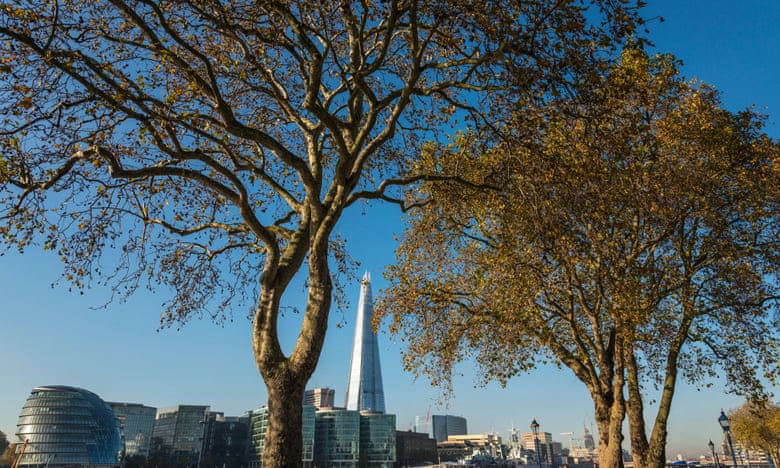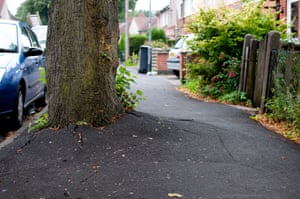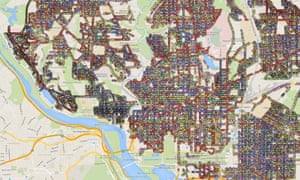Futures Forum: Urban forests
Futures Forum: Sidmouth Arboretum > Annual Tree Day >>> reports
This notion is very much connected with that of the 'urban tree canopy':
Urban Tree Canopy - National Geographic
Mapping Urban Tree Canopy

URBAN TREE CANOPY
What is Urban Tree Canopy?
Urban tree canopy (UTC) is the layer of leaves, branches, and stems of trees that cover the ground when viewed from above. In urban areas, the UTC provides an important stormwater management function by intercepting rainfall that would otherwise run off of paved surfaces and be transported into local waters though the storm drainage system, picking up various pollutants along the way. UTC also reduces the urban heat island effect, reduces heating/cooling costs, lowers air temperatures, reduces air pollution, increases property values, provides wildlife habitat, and provides aesthetic and community benefits such as improved quality of life.
Why Set UTC Goals?
Researchers estimate that tree canopy cover in urban and metropolitan areas across the U.S. averages only 27% and 33% respectively (Dwyer and Nowak, 2000). Additionally, the trees that are present are subject to a wide variety of stressors, which significantly shortens their lifespan. As such, it is important for urban communities to take steps to protect and enhance their urban forests through UTC goal setting processes. Few communities have developed land cover strategies such as UTC that mitigate urbanization effects regardless of land use type. Several recent efforts have explicitly included UTC in planning efforts to address community, environmental and human health concerns:
Watershed Forestry Resource Guide - Urban Tree CanopyAmerican cities are competing to have the most tree canopy cover:
Atlanta tree canopy - Wikipedia, the free encyclopedia
Tree Cover % — How Does Your City Measure Up? | DeepRoot Blog
A New Study in PLOS ONE Shows Strong Correlation Between Urban Tree Canopy Cover and Income Level - CityLab
The UK is not doing very well:
The UK is one of the least wooded areas of Europe, with 13 per cent woodland cover (Forestry Commission 2011) compared to around 37 per cent for European Union (EU) countries (Forestry Commission, 2010).
The State of the UK’sForests, Woods and Trees - Woodland Trust
The 'green city' of Bristol has the very impressive target of 30% canopy tree coverage:
Bristol Tree Forum - bristol.gov.uk
London is also trying very hard:
Trees and woodlands | London City Hall
Through the Arboretum project in Sidmouth, the aim is to increase tree coverage too:
Futures Forum: Greening the streets of Sidmouth
Treeconomics is leading several projects in the UK:
i-Tree Canopy surveys and reports on tree cover from Treeconomics – Treeconomics
Urban tree canopy cover comparison tool goes live online | Horticulture Week
Last week Kenton Rogers, founder of Treeconomics, presented the Sidmouth Arboretum's survey:
Futures Forum: Sidmouth Arboretum @ Sidmouth Science Festival >>> "What have trees ever done for us?" >>> launch of valley-wide tree survey >>> Weds 14th October
Kenton is very much involved in the urban tree canopy:
So, just what is the urban forest and why is is so important? Axe Magazine
Using canopy cover for urban forest management. Axe Magazine
Here is a piece from the Guardian earlier this year:
Introducing 'treeconomics': how street trees can save our cities
As a fight over 11 lime trees in Sheffield escalates, activists in cities all over the world are making the case for urban trees – to cut pollution, increase land value and even make you feel younger
Rustlings Road is aptly named. The street in Sheffield is lined with mature lime trees. Their whispering leaves are brilliant green in spring, then cast cool, dappled shade in summer and turn bright yellow in the autumn. But Sheffield city council wants to prune the street, and a dispute about 11 lime trees has turned into a citywide campaign, with more than 10,000 people urging the council to halt its roadside felling. I has also sparked a broader debate about what 36,000 street trees bring to a place that claims to be the most wooded industrial city in western Europe.
This tussle shows how urban trees are both treasured and in jeopardy like never before – beset by disease and spurious insurance claims, and too readily felled by cash-strapped local authorities which only see their potential cost rather than their contribution to climate, public health and even the wealth of a city. Ever since Roger Ulrich discovered in 1984 that hospital patients appear to recover more quickly from surgery in rooms with green views, a growing body of scientific evidence has demonstrated the health – and wealth – benefits of trees in cities.
In Toronto, researchers recently found that people living on tree-lined streetsreported health benefits equivalent to being seven years younger or receiving a $10,000 salary rise. As well as studies revealing benefits from everything from improved mental health to reduced asthma, US scientists have even identified a correlation between an increase in tree-canopy cover and fewer low-weight births. And economic studies show what any estate agent swears by: leafy streets sell houses. Street trees in Portland, Oregon, yielded an increase in house pricesof $1.35bn, potentially increasing annual property tax revenues by $15.3m.
Despite compelling scientific support for urban greenery, the trees on British streets are imperilled by the lack of any government department or national body to look after them (unlike government-owned woodlands, which are managed by the Forestry Commission). Urban trees stand at the mercy of cash-strapped local councils and a hotchpotch of agencies, from housing associations to highway authorities, who may overlook their true value. But as Sheffield residents mount a desperate defence of their mature street trees, some councils and planners seem to have grasped the value of their urban forest.
In Brighton, tree experts from across Europe gathered last month and called for World Heritage Status to be given to one of the city’s less feted attractions – its unique population of mature elm trees, which survived the Dutch elm disease that destroyed most of the species in the 1970s. London mayor Boris Johnson has planted 20,000 street trees in seven years, but this achievement – praised by tree experts – is dwarfed by Toronto’s mayor John Tory, who has planted 40,000 trees since his election victory last December and has promised 3.8m over the next decade.
City trees are now being mapped with new accuracy, showing the abundance of different species that line avenues everywhere from New York and Washington to the London borough of Southwark.
In London, an innovative survey will reveal the economic value of the capital’s “urban forest” – its estimated 8m trees. A suite of open-source software developed in the US called i-Tree maps city trees and calculates the financial value of the “ecosystem services” they provide. While street trees are a visible green stamp on a city, 70% of the “urban forest” is found in private gardens and places such as railway embankments, cemeteries and golf courses. i-Tree measures them all and, crucially, calculates tree canopy cover. It’s all then given a hard-headed financial value based on the carbon they store, the air pollution they remove, the rainwater they hold (allowing it to be re-evaporated by the sun rather than disappearing into drains and sewers) and how they ameliorate extreme temperatures. Trees that are close to buildings reduce air conditioning in summer, and even heating bills in winter – small effects that become extremely valuable in a big city.
The software has been deployed in European cities including Edinburgh, Barcelona and Strasbourg. Torbay in Devon was the first British council to trial it: the English Riviera resort famed for its palms discovered that its trees (mostly ash) stored 98,000 tonnes of carbon and removed 50 tonnes of air pollution each year - the equivalent of taking 52,000 family cars off the road. i-Tree showed that Torbay trees’ carbon storage was worth £1.5m, their pollution removal £1.3m, and the cost to replace them would be £280m. These facts helped the council’s tree officer win more funding for planting and maintaining its trees.
Jake Tibbetts, a committee member of the London Tree Officers’ Association, has led i-Tree surveys across London, using volunteers to reduce costs (a survey typically costs £30,000–£50,000 according toTreeconomics, the social enterprise that brought i-Tree to Britain). “One of the good things about trees is that people are passionate about them. If we were surveying street lamps and bollards it would be a lot harder to find volunteers,” says Tibbetts. He was surprised by what the surveys revealed: one of the commonest trees in central London is actually the apple tree, hidden in gardens.
Tibbets says: “i-Tree is a real opportunity to finally put a valuation on London’s tree resource and financial value is something that everybody can understand.” The survey isn’t truly comprehensive – it doesn’t calculate mental or physical health benefits, for instance, or the cultural value of trees – but Tibbetts is hopeful it will raise awareness of the “significant threat” to London’s urban forest. “Insurance claims [for roots causing building subsidence or uneven pavements that lead to accidents] are a large financial risk for local authorities, but for urban forests the main threat is development and complacency,” he says. “We believe we come from a green and pleasant land with lots of trees – when developers remove two trees, we think there are lots more.”
London’s i-Tree results will be published this autumn, and will prove that the capital’s trees are a multimillion-pound piece of infrastructure, but they will also show that the city has a problem – its dependance on London plane trees. These majestic giants give great pleasure to visitors to Westminster and the City and perform a vital practical role, too. Tibbetts recorded the temperature on London streets during the recent heatwave, and found that temperatures were 10C lower under the shade of grand planes than in the open street. “That’s going to be really important when temperatures increase with climate change,” says Tibbetts. “Trees are a low-cost way to make the city a comfortable place to live and work.”
According to Kenton Rogers of Treeconomics, no more than 10% of trees on one street should be of the same species. A Treeconomics survey found that 30% of all trees in London Victoria’s business improvement district were London planes, and because they are so big, they perform 60% of the ecosystem services in Victoria. “With climate change and the globalisation of pests and diseases,London is a bit more vulnerable than somewhere with a more diverse treescape,” says Rogers.
Disease is perhaps the most terrifying threat to London planes. A wilt disease has struck thousands of mature trees in France, and has now spread as far north as Lille. If it crosses the Channel, it would change the capital perhaps as dramatically as the blitz. But if it doesn’t, ageing plane trees will still have to be replaced. Rogers’ study of Victoria found that most were being substituted with species that won’t grow as large, and will never perform the valuable services that big planes do.
Keith Sacre of Barcham Trees, the largest container tree nursery in Europe, supplying more than 60,000 each year, says the standard street trees they sell to London boroughs are 3.5m high with a 14cm girth. He calculates that to replicate the leaf area of just one mature plane tree on the Embankment, 60 new trees would have to be planted. “One-for-one replacement is mad,” he says. “Planting has got to be slow, steady, planned and resourced. There has to be a long-term commitment to recognising trees as the asset that they are.”
Unfortunately, the replacement of mature trees with dainty ornamental species is a trend across many cities, creating “lollipop landscapes” according to Mark Johnston, author of Trees in Towns and Cities. “Local authorities are cutting back on their spending on tree maintenance and management so tree officers are reluctant to put in large trees. They’ll put in little lollipop trees that don’t contribute much to the landscape or deliver much in terms of ecosystem services.”
This, say residents of Sheffield, is exactly what is happening in their city. Ian Rotherham, professor of environmental geography at Sheffield Hallam, says the removal of street trees is the consequence of nearly a decade of austerity. “Big metropolitan districts have been seriously disadvantaged by the coalition and the current government reducing the amount of money they get per capita. The solution to really severe cuts has been public-private partnerships,” he argues. In Sheffield, the council signed a 25-year PFI contract with Amey in 2012 to manage and improve its roads, including greenery. Rotherham and other campaigners argue that Amey’s removal of mature urban trees is because it’s the cheapest option, minimising expensive pruning costs and damage to pavements. But requests for information about the costs of tree removal have been frustrated by “commercial confidentiality” cited by the council and its contractors. “Without any public consultation or awareness, we’ve somehow got locked into this situation where there’s a 25-year agreement about our green infrastructure in which local people have no say,” says Rotherham.
Terry Fox, cabinet member for the environment and transport at Sheffield city council, says it is a “myth” that removing mature trees is the cheapest option. The council says cannot reveal the comparative cost of removal and maintenance because it simply pays an annual charge for all services delivered under the contract, of which tree maintenance is one. “Sheffield is the greenest city in the UK, with more than two million trees – four for every person. This is something we are all very proud of. To help preserve our green status we have also, this year alone, planted 50,000 trees, creating 17 new woodlands,” says Fox in a statement. “The removal of any tree is always a last resort and we look at all viable options before removal is considered.”
In 2007, a survey suggested that 75% of Sheffield’s roadside trees were approaching the end of their natural life. The council’s tree-management policy is to remove and replace roadside trees that are dangerous, dead, dying, diseasedand damaging to the road or pavement, or cause “discrimination”. By this, the council means where roots damage pavements and potentially obstruct disabled or partially sighted residents. On Rustlings Road, however, campaigners filmed two mobility scooters travelling side-by-side, safely passing along the pavement below the “discriminatory” trees earmarked for destruction. “We’ve got a couple of “Ds” as well”, says local resident Louise Wilcockson. “We think the council’s response is disproportionate and they can use some professional discretion over the ‘dangerous’ trees.”
Sheffield city council has now established a “tree forum” for experts and residents to discuss plans for a city tree strategy next March. “We’re delighted, but how many trees will be cut down before then?” says Wilcockson, who is sceptical about the forum. As Fox puts it in his statement, it is “to enable the public to better understand our approach to managing the city’s street trees”. He confirms that the council is still planning to remove the 11 limes on Rustlings Road, and will replace these and plant nine additional trees on the street.
“This is not a parochial issue, it’s a huge issue about privatising local authority services,” says Rotherham, who has been contacted by residents in Birmingham, Southampton and Leicester also concerned about councils removing mature trees. “In Sheffield, the cost is [to] the tree resource, the value of Sheffield PLC, and the local people who are really, really upset. We shouldn’t belittle that - we know that trees make people happier and healthier.”
Introducing 'treeconomics': how street trees can save our cities | Cities | The Guardian
.
.
.






No comments:
Post a Comment